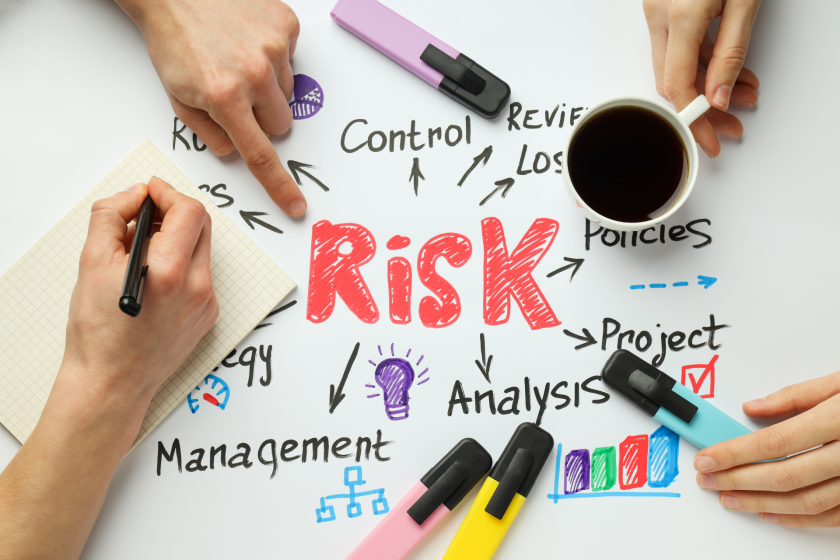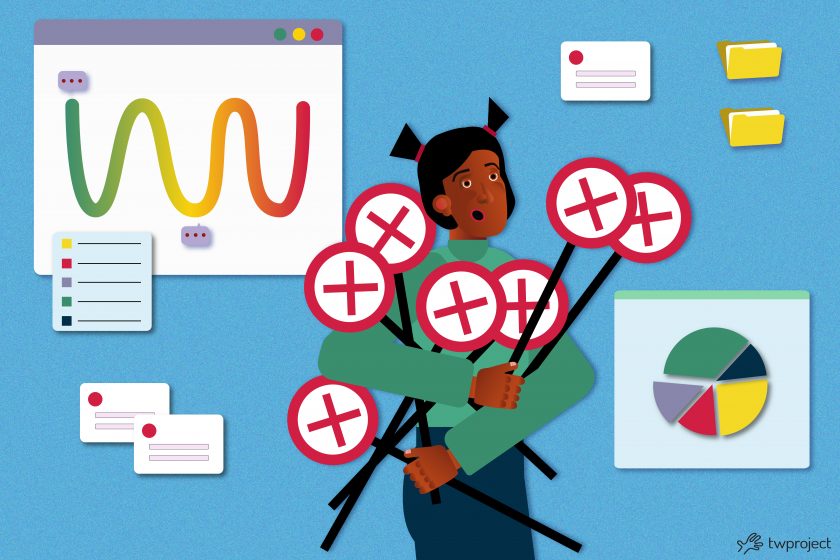Risk management in Projects is a core part of any project, regardless of its complexity or industry. The skill of predicting, identifying, and mitigating risks is crucial to project success.
Yet many companies make common mistakes in risk management, which compromise the achievement of their goals and increase the odds of failure.
In this article, we will explore 7 frequent mistakes in project risk management and how to avoid them.
CONTENT
- 7 mistakes in risk management in projects
- 1. Failing to identify risks adequately
- 2. Not performing an adequate risk assessment
- 3. Not regularly updating risk management
- 4. Not communicating risks effectively to team members and stakeholders
- 5. Not implementing effective risk mitigation strategies
- 6. Not considering risks associated with third parties
- 7. Underestimating the importance of a proactive approach to risk management
- How Twproject supports risk management in projects
7 mistakes in risk management in projects
1. Failing to identify risks adequately
Risk identification is the first step in the risk management process.
If risks are not identified from the very outset of the project, it becomes challenging to tackle them effectively. This mistake is widespread when project teams focus only on operational aspects, overlooking external or unforeseen factors that could impact the project.
In order to effectively manage risk, it is critical that the risk manager and project team employ a systematic approach to identifying risks. This includes analyzing internal factors, such as resources, timing, and expertise, and external factors, such as the market, regulations, and third parties.
For example, if a critical provision is sourced externally, the risk associated with delivery delays should be adequately considered.
2. Not performing an adequate risk assessment
After identifying risks, it is vital to conduct a thorough risk assessment to understand how much of an impact a given risk is likely to have on the project and how possible it is to occur. Often, project teams make the mistake of not investing enough time in risk assessment or doing it superficially.
A risk that might seem minor initially could become a serious threat if it is not monitored correctly. Furthermore, deciding which risk management strategy to adopt is complicated without proper risk assessment.
For example, if a project team is working on implementing a new e-commerce platform, a significant risk could be an unexpected increase in web traffic, which could overload servers and disrupt the user experience.
If this risk is not properly assessed, it could be overlooked, and the website could be knocked offline during a traffic spike, causing financial losses and damage to the company’s image.
Accurate risk assessment allows teams to prioritize the most critical risks and allocate resources strategically.
3. Not regularly updating risk management
Risk management is not a once-and-only process that takes place at the beginning of a project. Risks can be dynamic and change over time. If risks are not monitored and refreshed regularly, they may evolve in a way that is beyond the project team’s control.
For example, in a construction project, a risk might be related to the availability of building materials.
If risks are not monitored and constantly checked by the supplier throughout the course of the project, the risk of supply delays may not be perceived until it is too late.
Regularly updating the risk management plan could help spot potential issues early and adopt preventive measures, such as identifying alternative suppliers. The project team must constantly update the plan to address new risks as they arise, especially if there are changes in business efforts or external factors such as the economy or technology.
4. Not communicating risks effectively to team members and stakeholders
Communication is one of the most critical aspects of risk management. Another common mistake project teams make is not informing team members and stakeholders properly about risks. This leads to poor preparation and, eventually, ineffective risk management.
For example, in an IT project, if the development team does not effectively communicate cybersecurity risks to the legal department, the risk of a data breach may not be addressed until an attack occurs. Lack of communication leads to delays in implementing adequate protection measures.
All team members should be aware of the risks and the actions to be taken to mitigate them.
Furthermore, stakeholders should be regularly updated on the project’s status to prevent surprises or misunderstandings. Clear and transparent communication helps to enhance cooperation between the project team and third parties, reducing the risk of conflict and inefficiencies.
5. Not implementing effective risk mitigation strategies
Once the risks have been identified and assessed, the next step involves adopting mitigation strategies to minimize their impact on the project.
A common mistake in this context is the lack of concrete risk management strategies or the use of overly generic solutions.
Risk management strategies should be specific and tailored to the type of risk identified. For example, a risk related to resource shortages may require a backup plan for personnel or procurement, while a cybersecurity risk may call for technological upgrades or ongoing training for team members.
When implementing effective cybersecurity measures as part of your risk mitigation strategy, consider utilizing a strong free password generator to ensure all accounts are secured with complex and unique passwords.
In some cases, risk management involves transferring the risk to third parties. For instance, an insurance contract can be used to transfer risks related to physical or financial damage, while a partnership with a reliable collaborator could reduce the risk of supply chain disruptions.

6. Not considering risks associated with third parties
Many projects depend on resources and supplies provided by third parties, such as subcontractors, software suppliers, or business partners. Risk management becomes particularly complex in terms of monitoring and managing the risks associated with these external entities.
Failing to manage risks from third parties can seriously compromise the project. For example, a vendor that misses deadlines or experiences a disruption in its operations could lead to significant delays. In these cases, the project team should have firm contingency plans and clear contracts that define responsibilities and actions to be taken in case of problems with third parties.
Another common mistake is not correctly assessing a partner’s financial standing or reputation before partnering.
Risk management should always include an assessment of risks associated with third parties, and ongoing monitoring mechanisms should be established to ensure that risks are dealt with promptly.
7. Underestimating the importance of a proactive approach to risk management
Another mistake is to take a reactive rather than proactive approach to risk management.
Risk management can only be effective if it is undertaken before a problem occurs, not after. Many project teams respond to problems as they happen instead of planning to prevent such issues.
For example, if a data security risk is not managed ahead of time, the discovery of a data breach could have disastrous consequences. A proactive approach involves identifying and assessing risks and implementing preventive measures to prevent these risks from becoming a reality.
How Twproject Supports Risk Management in Projects
Twproject is a one-stop shop project management platform that offers cutting-edge features to help teams manage risks more effectively and proactively.
Risk management is a core element of any project, and Twproject simplifies this process, making it intuitive and well-structured. With its user-friendly interface and built-in tools, it helps risk managers identify risks in real-time and develop strategies to address them before they can negatively impact their project.
One of the most valuable aspects of Twproject‘s central management of business efforts is making it easier to assess risk by constantly monitoring resources, deadlines, and dependencies between tasks. This means that each team member can see how activities intersect, the priorities, and how any changes might impact the overall project.
Leveraging alert features and detailed reports, this platform helps project managers ensure that no risk goes overlooked. Teams are constantly updated on potential risks, allowing them to take quick and decisive action.
With Twproject, every risk management process step becomes more straightforward as the platform centralizes all the information needed to make informed decisions. This helps project managers reduce uncertainty throughout the project lifecycle, minimizing the risk of unexpected events and ensuring the project progresses without hiccups.
Ultimately, risk management is a key aspect of the success of any project. Preventing the seven mistakes discussed in this article can make all the difference between the success and failure of a project.




